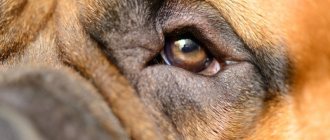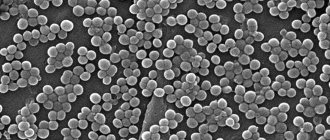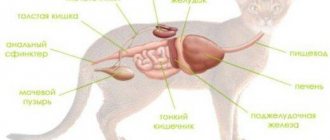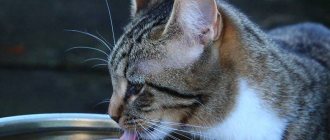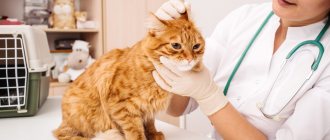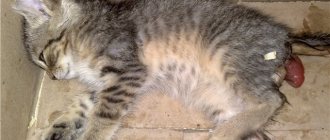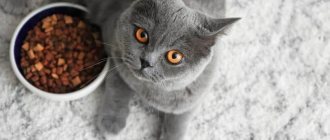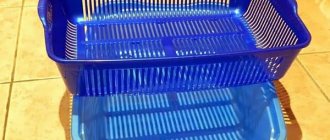Treatment of tartar in cats
Tartar removal is carried out in veterinary clinics.
The procedure is carried out under general anesthesia, as it causes the animal very unpleasant sensations and severe pain. The procedure for removing tartar lasts on average from 30 minutes to 1 hour, depending on the degree of tooth damage. It includes the following steps:
Mechanical chipping. At this stage, the growths are lubricated with lactic acid. Then they begin to chip away the stone using a skeller (a special dental device). Ultrasound cleaning. This manipulation is necessary to remove small parts. In the initial stage of tartar formation, when the growths are still small, ultrasonic removal is usually sufficient. This procedure does not injure tooth tissue, unlike mechanical chipping
This is why it is so important not to start this process. Grinding and polishing. A special paste is applied to the teeth, which destroys pathogenic bacteria and allows you to even out damaged enamel.
The treated oral cavity is rinsed with an antiseptic and treated with an astringent so that tartar cannot form again.
The procedure for removing tartar is very painful, so it is performed under general anesthesia.
It is almost impossible to remove tartar on teeth at home due to the complexity and pain of the procedure. You shouldn’t even try to mechanically remove it yourself. This can lead to painful shock for the animal and serious health problems. If it is impossible to take your pet to the clinic, you can use a chemical method of elimination, for example, using Tropiclean gel. When applied to teeth, it softens growths and destroys pathogenic bacteria. The way to use it is quite simple:
- 30 minutes before using the gel, the cat should not be given food or water.
- It is necessary to apply the product in the amount of two drops to the animal’s teeth and immediately brush them with a toothbrush.
- The product is used daily for a month, and then it can be used as a preventative measure 2 times a week.
It is difficult to get rid of tartar at home, but you can try to remove it with special chemicals.
Treatment of tartar is complex. It includes not only its immediate removal, but also the elimination of associated diseases. As a rule, dental plaque removal is carried out using a special ultrasonic scaler device. This is a modern dental device with an autonomous water supply, which allows you to remove deposits without traumatizing the tooth enamel from the tooth surface, as well as rinse the periodontal canal.
In itself, this is a painless and safe procedure, but, unfortunately, since the stone accumulates to a greater extent in hard-to-reach places, and some teeth must be removed, as a rule, it is necessary to carry out sanitation under general anesthesia. Therefore, if the animal is elderly, has a breed predisposition to the development of certain defects, or has a history of diseases of the internal organs, it is recommended to undergo a preliminary examination, which includes blood tests and heart ultrasound to exclude anesthetic risks.
Treatment of tartar comes down to its thorough removal. In cats, the operation is performed under general anesthesia and lasts about an hour.
There are two methods for removing dental plaque – mechanical and ultrasonic.
Ultrasonic cleaning is a modern and painless method. It is carried out with special equipment. Ultrasonic waves destroy hard calcareous deposits and peel them away from the tooth tissue. In addition to removing plaque and stone, the interdental spaces and periodontal pockets are cleaned, and pathogenic microorganisms are neutralized. In this case, the enamel is not injured, and anesthesia is only necessary to immobilize the animal.
Ultrasound removal of tartar from a cat
Polishing
After brushing, the tooth surface remains rough, which increases the rate of re-formation of deposits. Polishing is necessary to ensure the enamel is perfectly smooth. It is carried out using special brushes and pastes.
Fluoridation
Fluoridation is an optional but desirable step in cleaning tartar in cats. A special gel or varnish containing sodium fluoride is applied to the teeth. The purpose of fluoridation is to reduce tooth hypersensitivity and strengthen enamel to prevent caries.
Self-removal of tartar
If the owner finds thickening plaque on the pet’s teeth, you can try to remove it yourself at home:
- Xident Elixir - sold in pharmacies. The mechanism of action of the drug is to soften tartar. A small amount of the product should be soaked into several layers of gauze or a cotton pad and then applied to the affected tooth. The holding time of the “compress” is 30 seconds. When the stone becomes soft, it can be easily removed with a special toothbrush.
- Tomato paste. This product is similar in its effect on the stone to Elixir Xident, and in addition, the method of application is identical. You can use tomato paste as a means of prevention.
What not to do.
To remove stones at home, it is strictly forbidden to use a dental instrument - sclera.
Removing plaque with its help is a very painful procedure that has a high risk of damage to tooth enamel and soft tissues. You can only remove minor plaque on your own. If the stone is fully formed, it should be removed by a veterinarian in a clinic under anesthesia.
Also watch the video about how dangerous tartar is, how to remove it and how to avoid its formation:
How to determine a cat’s tendency to form tartar – symptoms and consequences
Absolutely all people, cats and other pets are prone to the formation of tartar. The main reasons are violation of hygiene rules, ignoring preventive measures, unhealthy diet and lifestyle.
Among the many reasons, we can identify factors that particularly increase risks:
Popular breeds are Siamese, Persian, Scottish and British Fold cats. Many breeders are involved in breeding these breeds, unfortunately, not always decent ones. Mixing of related blood and “translation” of the breed for financial gain has been weakening the gene pool of animals for years, as a result of which cats have become prone to diseases. “Yard” cats, whose generations are replenished and thinned out every year, are less susceptible to genetic mutations, so they have stronger immunity. However, their living conditions contribute to diseases.
A metabolic disorder is a congenital disorder that cannot be completely cured. Plaque is formed due to the excessive content of salts and trace elements in saliva. Cats with this condition require regular hygiene procedures.
Malocclusion is a congenital or acquired deviation. Leads to disruption of the natural removal of plaque by friction.
Roughness of enamel – this feature is as common in cats as in humans. The rough surface of the teeth is not a deviation, but requires constant monitoring.
Unnatural feeding - compassionate owners often follow the lead of the little tricksters and feed them exclusively boiled fish, canned food or dry food. In nature, cats gnaw bones, chew tendons for hours, eat grass and the bark of branches - this is a natural process of cleaning their teeth.
Advice from the breeder! Dear owners, stop indulging your pets in the way they eat. Almost all pets are manipulators - accept it. Realize that by being sorry you are harming them. If your pet refuses to eat, don't panic! In the practice of keeping animals, there are no cases of starvation with a full bowl of unloved but healthy food.
The modern pace of life and the quality of food make it much more difficult to maintain the health of both owners and their pets. Brushing teeth and removing tartar in cats is a necessary measure for a pet’s comfortable life. You can diagnose the presence of tartar at home. If your pet exhibits the symptoms listed below, do not delay and contact your veterinarian for professional examination and treatment.
A cat frequently shakes its head - an ambiguous sign. It is worth understanding that oral disease can lead to complications that can affect the ears, nasolacrimal ducts and mucous membranes. The degree of damage is diagnosed by a veterinarian.
Trembling when chewing or refusing to eat is a clear sign of pain.
The cat has an unpleasant smell from its mouth - a pungent, rotting smell. The reason may be dental disease or problems in the digestive system.
Redness or bleeding of the gums, visually reminiscent of human periodontal disease.
Visually recognizable plaque or crusts at the base of the teeth - the color can vary from yellowish to dark brown. As it progresses, the stone affects the chewing teeth, canines, and then the front incisors. Examples in the photo below.
If you ignore the symptoms, the animal not only suffers, but also risks acquiring ailments that are more difficult to treat:
Caries - a favorable environment for bacteria contributes to the destruction of enamel.
Gingivitis is the initial stage of periodontal disease.
Periodontal disease is an infectious disease of the gums that leads to bleeding and loose tissue, resulting in tooth loss.
Pulpitis is an inflammation of the dental nerve leading to constant acute pain.
Stomatitis is a bacterial infection of the oral cavity. It is fraught with the formation of acid plaque, corrosion of enamel, and a burning sensation.
Brittle teeth – thinned enamel and the affected tooth body become softer.
Important! Tartar is found not only on the visible part of the tooth, but also under the gum. Even if visually the lesion appears to be minor, there may be a serious risk of complications.
Causes of tartar formation
- Regular feeding of soft foods does not help clean the tooth surface.
- Internal diseases of the gastrointestinal tract can lead to changes in the acidity of saliva and provoke the formation of plaque.
- A malocclusion - acquired or congenital - leads to one-sided chewing, teeth rubbing against each other and against the inner surface of the cheek, making it difficult for the teeth to self-clean.
- Abrasion and damage to the surface layer of tooth enamel, which leads to rough teeth and plaque retention.
- Disturbance of salt metabolism in the body.
Initially, a soft plaque (soft plaque) forms on the surface of the tooth, especially on the root neck, which consists of:
- leftover food;
- bacteria;
- natural mucus, which glues all components together.
Localization of plaques occurs mainly on the back of cats’ teeth and fangs. That is, where, when chewing food, insufficient self-cleaning of the teeth and mouth cavity occurs.
Subsequently, mineralization of deposits occurs with salts of phosphorus, calcium, iron, and as a result, hardening of tartar.
Causes of dental disease in cats
All teeth in cats, like in humans, are theoretically susceptible to mechanical damage, for example, when a tooth breaks due to a head injury or as a result of a strong blow. However, most often, pathologies of the dental system in cats have the following causes:
- Genetic failure. Often, defects in the structure of the oral cavity and an inherent hereditary factor of predisposition to diseases are found in selective breeds of cats.
- Pathologies of bite and enamel. In some breeds, several permanent teeth are missing from birth, which leads to accelerated wear of the remaining teeth and thinning of the enamel.
- Ecology - the influence of chemicals and carcinogens in air, water and food.
- Infections that can cause abscesses leading to tooth loss.
- Lack of oral hygiene. If the owner does not promptly eliminate plaque on his pet’s teeth, its layer is transformed into hard tartar, which can damage the gums and lead to the appearance of even more serious pathologies.
Types of malocclusion
Symptoms
The very first signs of the disease are the appearance of an unpleasant specific odor from the mouth and a yellowish coating. In the advanced stage, you can see abundant deposits of brown tartar, often larger in size than the crown itself. The gums become inflamed, red, and may bleed. Gingivitis develops. The process of eating food can be painful and unpleasant for the animal. Increased salivation may occur. Subsequently, cavities may form between the tooth and the gum, as a result of which the teeth begin to be loosely held in the sockets and become loose. Inflammation affects deeper and deeper layers, and periodontitis develops.
Tartar in a cat.
Types of tartar in dogs and cats and why the disease is dangerous
There are several types of mineral deposits on enamel:
- supragingival - soft, easily identified upon examination, has a yellowish color, and is easily removed.
- subgingival - a solid dark formation, located on the surface of the root, detected using a probe.
If you do not seek veterinary help in time, the infection will penetrate under the gums, periodontitis will develop, and over time, serious problems with the digestive system may appear due to bacterial toxins. Often it is necessary to carry out the procedure of removing the affected fang. Due to the large accumulation of bacteria in the oral cavity and their waste products, the level of intoxication of the animal increases, diarrhea, constipation appear, sepsis and death of the pet may occur.
Symptoms of Tartar in Dogs and Cats
Even before the disease begins to manifest itself visually, some of its symptoms become obvious:
- an unpleasant odor begins to be felt from the animal’s mouth;
- gums bleed.
As the disease progresses:
- the animal loses its appetite;
- there is swelling of the gums;
- frequent refusal to eat;
- bleeding gums increases.
Most often, the problem occurs where the load on the enamel is small - on the back and front surfaces.
Treatment of tartar in dogs and cats
Animal veterinary dentistry involves several methods for removing tartar in dogs and cats. The method of combating plaque depends on the stage of the disease. You can fight plaque on your own using preventive methods only in the early stages of the disease, when the plaque has not yet hardened. Only a veterinarian can completely remove hardened plaque salts using dental instruments in a veterinary clinic, in particular using ultrasonic cleaning. This is done under general anesthesia. Ultrasonic cleaning does not harm the enamel in any way and effectively removes plaque. The procedure itself lasts about half an hour. Further treatment consists of eliminating the inflammatory process. Tartar in dogs and cats can be removed at any of our clinics in Moscow and the Moscow region. The cost of our veterinary services is very affordable and will not be a big burden for the owner.
Prevention of tartar in dogs and cats
Methods for preventing oral diseases are no less important for your pet’s health. Tartar in dogs and cats can be prevented if basic hygiene is not neglected. An important hygiene procedure is brushing with a toothbrush using animal pastes 2-3 times a week.
It is important to include not only soft, but also hard food in the animal’s diet. Regular examination at a veterinary clinic will help to identify any health problems in a timely manner.
Execution technique
Ultrasound removal of tartar in cats allows you to avoid damage to the gums and pain in your pet. An additional plus is the whitening effect and cleaning of gum pockets from pathogenic microorganisms, food debris and dead tissue. The average session duration is 30 minutes, but much depends on the stage of the disease and the number of formations in the oral cavity.
To carry out a planned procedure, the animal needs a scaler device.
Cleaning is carried out with a special device - a scaler, which creates vibrations in the ultrasonic range. The noise of operating equipment and the vibration it creates can cause discomfort to a cat. But the pain of the ultrasound scaler is a misconception. If the procedure takes place without anesthesia, then the animal is held. Many clinics allow the presence of the owner. The device is inserted into the mouth of a lying cat, brought closer to the affected tooth and the stones are removed.
It is dangerous for older cats to undergo anesthesia, so veterinarians recommend first calming the animal with the help of special cat pheromones, for example, Feliway.
After ultrasonic cleaning, small crumbs remain on the animal’s fangs, making them rougher. These are favorable conditions for the formation of new deposits, and therefore veterinarians insist on mandatory polishing of the enamel. The procedure involves treating the fangs with several brushes with varying degrees of hardness. Veterinarians also select the most suitable type of toothpaste. The cat's oral cavity is washed with a disinfecting solution that destroys pathogenic microorganisms. The final stage is to treat the canines with a high fluoride gel to reduce sensitivity, prevent darkening and have a strengthening effect.
Complications
As tartar develops, a gum pocket forms. Hard deposits mechanically irritate the gum, causing it to detach from the root; waste products of bacteria cause inflammation, tooth damage, and tooth loss.
Let's consider the complications that arise as a result of tartar not being removed in time.
Gingivitis
Gingivitis is inflammation of the gums. Characterized by redness, swelling, bleeding, and unpleasant odor from the mouth. Ulcerations of the mucous membrane may occur.
Periodontitis
Periodontitis is an inflammation of the tissues surrounding the tooth and holding it in the alveolus. It is a consequence of gingivitis. Causes tooth looseness and tooth loss.
Exacerbations of periodontitis:
- purulent discharge from the gum pocket,
- abscesses and fistulas of the gums,
- inflammation of the submandibular lymph nodes.
Caries
Caries is the destruction of tooth tissue. Dental plaque contains a huge amount of cariogenic bacteria, which cause demineralization of enamel, destruction of hard tooth tissues, inflammation of the pulp and periodontium.
Periodontitis
Periodontitis is an inflammatory process characterized by the destruction of bone tissue. Treatment is long-term and may result in death.
A complication of excessively overgrown tartar is periodonitis.
Osteomyelitis
Osteomyelitis is a purulent inflammatory process affecting the bone, surrounding soft tissue, and bone marrow. Death from sepsis is common.
Warning! Timely removal of tartar will protect your cat from dangerous complications!
What is tartar
The assumption that a cat's teeth do not require any care is deeply mistaken. Despite this, not every owner engages in preventative cleaning of their pet’s teeth at least once a month. As a result of lack of care, the animal’s teeth naturally become “overgrown” with layers of plaque, which gradually accumulates into what dentists call stones.
Tartar itself is a collection of several main components:
- calcium and phosphorus contained in cat saliva;
- iron;
- unchewed food particles remaining after each feeding;
- waste products of bacteria inhabiting the oral cavity of an animal.
The layers of dental plaque that lead to the appearance of stone have a complex composition
Of course, not all bacteria in a cat's mouth are harmful. However, those of them that belong to the pathogenic group gradually destroy the enamel of the teeth, as well as their soft body. Therefore, in addition to the manifestation of stones, in cats whose teeth no one has taken care of, stomatitis, pulpitis and other diseases of the oral cavity can be detected, causing great discomfort.
How does tartar appear?
In its development, tartar goes through several stages. The very first of them is a yellow coating, which can be completely invisible to the owner. However, the appearance of yellowness in itself indicates that it is advisable for the animal to have its teeth cleaned (at home or in a veterinary clinic).
Normally, a cat's teeth should be white.
Over time, the plaque begins to darken. This is most quickly detected in those areas of the jaw that do not involve frequent friction between the teeth, which contributes to their natural cleansing. The change in color of plaque as it flattens is explained by the fact that tartar consists of pores that absorb various food dyes well. The stone gains hardness due to the active activity of microorganisms that secrete insoluble mineral compounds.
Timing of formation of tartar
It is difficult to say exactly the time during which a particular cat develops tartar. The timing is influenced by both the feeding characteristics and jaw structure of the animal, as well as its breed. It is believed that it takes from three to six months to “create” formed tartar.
Cats of all ages attend dental appointments to remove stones.
Cats in adulthood are more susceptible to the formation of tartar. Young pets under three years of age are extremely rarely affected by this disease. However, in recent years this statement has been disputed, and veterinarians are beginning to clean the teeth of kittens who are less than a year old from stones.
Location of tartar
In total, there are only two options for the location of tartar:
- above the gum (such stones are called supragingival). Stones located above the gum are visible even to the naked eye and are the easiest to remove. Even pet owners themselves can cope with them at home if they resort to additional compounds that soften the structure of the stone and allow the formation to be removed without dental instruments.
- under the gum (such stones are called subgingival). Typically, stones located under the gums are darker in color and more difficult to clean. Due to the fact that subgingival stones are located directly under the root of the tooth, their correct removal at home is practically impossible. The best way to combat such deposits is ultrasound.
In most cats, stones primarily cover the incisors and canines, later moving to other teeth. The first to be hit is, as a rule, the upper jaw. It has also been repeatedly noted that stones prefer to form on those molars that are adjacent to the cheeks.
How to recognize tartar
Sometimes it is difficult for pet owners to determine the presence of tartar in animals. Signs of the disease:
- Bad breath, reminiscent of rotting. There are several reasons for this smell, ranging from problems with the gastrointestinal tract to oncology. But there is a high probability of the presence of tartar in the oral cavity, if no other painful manifestations are observed in the cat’s body.
- Bleeding gums and itching when hard stones injure the soft mucous membranes of the cat’s mouth. Redness of the gums may occur.
- The animal's eating style changes: the cat begins to twitch its muzzle or shake its head when chewing, sometimes reducing its diet.
- Change in tooth color from yellow at the top to dark at the gums. This is where the stone begins to grow into the gum.
- Increased salivation is rarely observed.
- The cat avoids contact with the sore side of the face and does not allow it to be touched.
- Refusal to eat. The cat begins to meow and hide from its owners. The appetite remains, but preference is given to liquid food, which does not cause discomfort.
- Increased irritability of the cat with dissatisfied rumbling and periodic shaking of the head.
- The presence of swelling of the oral mucosa and the inner surface of the cheeks, external swelling of the animal’s eyes.
Removal at home
Tartar removal is a fairly painful procedure that lasts from 30 to 60 minutes. As a rule, cleaning is carried out in three stages; only compliance with all stages will help to efficiently clean the resulting growths on the teeth. If the procedure was performed poorly or without any point, then the stone will form again, and the animal will have to go through this unpleasant procedure again, which includes:
- Mechanical removal of large stones using dental instruments.
- Ultrasonic cleaning is performed to remove small stones.
- Grinding and polishing of teeth is done using special pastes.
If the animal is old or sick and cannot withstand general anesthesia, then the veterinarian develops a step-by-step treatment of the growth, which is carried out without the use of anesthesia, under the influence of painkillers. In this case, the stone is removed gradually, over several visits to the clinic.
Under no circumstances should you remove tartar at home, as this can cause severe pain to your cat and damage its health.
If, after an examination, the veterinarian prescribed surgery using general anesthesia, the owner must prepare the pet for this unpleasant event at home:
- The young animal must prepare by fasting, which lasts from 12 to 24 hours.
- Elderly cats, or those pets that have any health problems, should be prepared before surgery using laboratory tests and a careful examination by a veterinarian.
After treatment has been carried out, the cat will need careful care, which includes:
- Painkillers that can be given at home.
- Food should be semi-liquid, gentle and lukewarm.
To remove tartar at home, many gentle products have been developed that you can easily use yourself. But you need to know that this is a longer process than procedures in a clinic.
Hydrogen peroxide
This product can remove plaque from teeth, but you must act very carefully, without touching the gums. Moisten a cotton swab with peroxide and wipe the teeth where plaque is visible. After the procedure, you can rinse with chamomile decoction.
After the procedure, you can rinse with chamomile decoction.
Chew toys
Toys with an abrasive surface remove plaque and massage the gums. And so that cats enjoy chewing them, the toys are soaked in catnip.
Medicinal food
Dental foods for cleaning teeth exist in a wide variety; they remove plaque on teeth well, but cannot cope with tartar.
Special brushes
They exist in the form of a fingertip made of silicone. The brush is placed on the finger and is used to massage teeth affected by plaque.
To enhance the effect, you can apply preparations for cleaning cats' teeth.
They are able to soften tartar and have an antimicrobial effect, but treating your pet’s teeth requires effort: wrapping your finger in a napkin, you will have to rub the teeth.
Tartar removal is a difficult operation that is performed exclusively in a hospital setting. This is a rather painful procedure that is performed only under anesthesia.
Then the enamel is polished. The better your teeth are polished, the less chance of new plaque forming. The operation usually takes half an hour.
Stone removal procedure
However, it is not prohibited to use a special tropiclin gel at home to remove plaque. This process is long and laborious. Of course, it will not help with large deposits. A gel based on plant components softens the stone on the teeth and allows you to remove it with a regular brush. It is used in the morning and evening after meals, the course of treatment is 1 month.
It is necessary to remove tartar strictly under anesthesia, since the procedure is quite painful. In order to avoid stress when brushing your teeth, doctors recommend getting used to these manipulations from childhood.
Preventing the formation of tartar on teeth
It is quite possible to prevent the formation of mineralized deposits in your pet’s mouth if you take timely care of its health.
The following preventive measures will help your animal avoid unpleasant procedures:
cat food is selected taking into account the physiological characteristics of the pet’s body: food must be balanced, enriched with a complex of essential vitamins and minerals;- constant brushing of teeth (2-3 times a week) using a paste based on chlorophyll and enzymes;
- Regular visits to the veterinarian in order to identify problems in a timely manner.
If you notice a slight plaque on your pet’s teeth, you should try to remove it using a suitable method. It is not advisable to feed and water the cat half an hour before the hygiene procedure.
Why does education happen?
There is an opinion that only certain breeds of cats are prone to stone formation, since closely related matings, in order to preserve the purity of the breed, lead to mutations and weakened immunity. However, in reality, health problems in animals develop more likely due to improper care.
Veterinarians claim that feeding your pet soft food contributes to the appearance of plaque. In nature, cats are forced to crunch bones and chew tendons, which helps them clean their teeth without outside help. In addition, education provocateurs can be:
- Malocclusion. Cats may have crooked teeth. Congenital anomalies and some injuries received by the animal are to blame for this. If the teeth are positioned incorrectly, the chewing process is disrupted, which leads to the formation of stone.
- Disturbance of metabolic processes. This pathology is congenital and leads to the formation of an excessive amount of mineral salts in the pet’s saliva. In such a case, it is impossible to prevent the formation of stones. You will have to get rid of it periodically at the veterinarian's office.
- Roughness of enamel. This innate feature of some animals allows microparticles of food, salt, etc. to settle on the surface of the teeth and harden. If a cat has this feature, it must be regularly shown to the veterinarian.
- The presence of inflammatory processes in the pet's mouth. When a focus of inflammation appears, the pathological microflora quickly multiplies in the mouth, as a result, the processes of plaque formation and hardening are accelerated.
- Insufficient oral hygiene. Pets need to regularly brush their teeth using special products so that they do not have to remove the stone later.
It is important to prevent the appearance of tartar in the purr, otherwise the pet’s health will be in danger. Plaque on teeth is a real haven for bacteria
Parasites demineralize the enamel, causing caries, inflammation of the pulp and periodontium.
What health problems can arise due to tartar?
Owners often underestimate the possible problems an animal may have due to accumulated deposits. In the future, this threatens many problems for the pet:
- The stone spreads over all the teeth, which in the future can lead to their destruction.
- Accumulated plaque has a bad effect on the immune system. Exposing you to frequent infectious and viral diseases.
- Due to the active proliferation of bacteria in the oral cavity, such animals are more prone to gastrointestinal and liver diseases.
Read here Subcutaneous mites in cats - first symptoms, treatment options and real photos of examples of parasite damage (110 photos + video)
Often pets do not show their pain, but over time, eating will become painful and the animal may refuse to eat.
Varieties
Caries is divided into several groups:
- The first stage, when the disease is expressed by darkening of the tooth enamel, is called spotted caries.
- Superficial caries. Black indentations appear on the enamel.
- Average type of caries. This type affects the dentin structure in addition to the enamel.
- Deep caries. The damage reaches the pulp.
To protect your pet from an unpleasant illness, choose the right food for your cat, which will be rich in all the necessary vitamins and substances. Those cats whose genetics are prone to plaque should be fed with special veterinary food.
When does tartar appear?
In the modern world, in conditions of unstable ecology, poor nutrition, and the questionable emergence of new breeds of cats, pet owners are increasingly faced with various diseases, including tartar on their teeth.
This disease does not sound so serious, but every year it affects more and more furry pets.
Tartar is a mixture of bacteria, food debris and mineral salts contained in saliva. First, just a dark plaque forms on the surface of the tooth, which subsequently crystallizes into small particles. That is why they are firmly held on the tooth enamel.
Tartar is formed as a result of improper feeding of the animal.
Animals older than three years of age are usually susceptible to tartar.
But with improper nutrition, feeding only wet food, plaque may appear in a young kitten.
Removal
In order for your pet to undergo the procedure without stress and without pain, general anesthesia is used. The removal method is selected individually by a veterinarian and depends on the severity of the lesion:
- Laser removal - used for small stone sizes, if the pathological process has not yet affected the sinuses of the gums. This method is painless; anesthesia is necessary to immobilize the pet. The advantage of laser stone removal is that there is no risk of damage to enamel and soft tissue.
- Grinding – carried out with minor plaque. First, a special paste is applied to the teeth, which has a disinfecting and disinfecting effect. This paste helps even out tooth enamel. During the grinding process, partial removal of the enamel occurs and the gums may be injured. However, these complications are usually inevitable.
- Manual method. The procedure is carried out with special instruments and is used in severe cases of the disease, if there are plaques and extensive growths.
- Fluoridation is an additional step in the stone removal procedure that is recommended. The main task is to coat the crowns with a special varnish or gel containing sodium fluoride. Fluoridation reduces the increased sensitivity of dental tissue and has a strengthening effect on the enamel. In addition, fluoridation helps prevent the development of caries.
- Polishing is the final stage of the procedure. After grinding, the enamel remains rough, which greatly increases the likelihood of the stone forming again. To prevent relapse, the enamel must be polished to a perfectly smooth state. Polishing is carried out using specialized pastes and brushes.
Ban on anesthesia. There are cases when it is not possible to use anesthesia - these are:
- old age of the pet - anesthesia can cause negative consequences, including death;
- kidney, liver and heart diseases;
- abnormalities in the functioning of the central nervous system;
- tendency to allergic reactions.
If there is a risk of complications that could negatively affect the health of the animal, the procedure is carried out in several stages.
Actions after the procedure. After removing the pathological formation, it is recommended to give the cat painkillers, follow a diet, serving light, warm food. Painkillers should also be given if necessary. Due to the risks of relapse in the future, the owner should carefully monitor the condition of the pet’s oral cavity.
- teeth in cats: diseases and care;
- what to do if your cat has toothache;
- how to feed a cat correctly.
Reasons for appearance
As mentioned above, the main cause of the problem is eating exclusively soft foods, such as canned food and cereals. But there are a number of other indirect reasons for the appearance of deposits:
- incorrect position of teeth;
- complete lack of oral care;
- the presence of inflammatory processes on the gums;
- bad teeth;
- disturbance of mineral metabolism, which affects the quality of saliva;
- increased roughness of tooth enamel.
One of the reasons for tartar on an animal’s teeth is improper care of its oral cavity.
Cats with metabolic disorders are at risk. This is a congenital pathology that cannot be treated by any means. As a result of such changes, the metabolism of mineral salts is disrupted.
Increased tooth roughness is an individual characteristic of a cat and contributes to an increased build-up of deposits on the teeth.
Among the breeds susceptible to stone formation, doctors especially highlight Persian, Siamese and Scottish Folds. Because sometimes unscrupulous breeders spoil their gene pool, thereby weakening their immunity.
Cat's teeth before and after brushing
Under certain conditions, a soft coating of saliva, food debris, bacteria, calcium salts, phosphorus, iron, magnesium, and silicon forms on the surface of the teeth. The mass is gradually impregnated with mineral substances, thickening and hardening. Color may vary from yellow to dark brown. The formation of tartar lasts for six months. Old and weakened animals are most predisposed to its formation.
Let's consider the reasons for the appearance of tartar:
- feeding predominantly soft, “refined” foods;
- violation of mineral metabolism;
- malocclusion;
- dental defects, both congenital and acquired;
- genetic predisposition.


